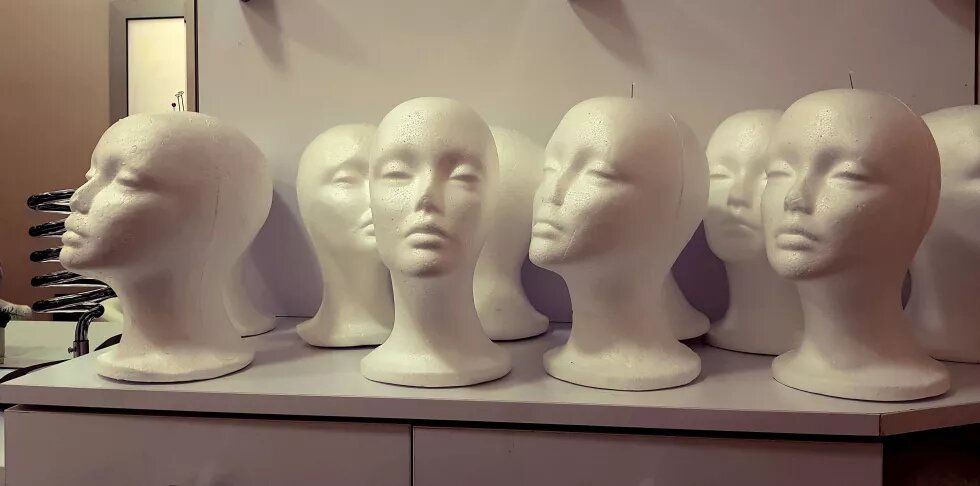The article is based on Ketevan Lapachi’s doctoral research, which explores and analyses practices related to hair loss. To conceptualise these practices, the author provides an overview of literature focusing on the relationship between the body and the discourse, while also discussing new ways of seeing and understanding the human body.

In the conclusion of her 1985 essay “A Cyborg Manifesto: Science, Technology, and Socialist-Feminism in the Late 20th Century”, Donna Haraway, an American feminist author, wrote: “I would rather be a cyborg than a goddess” (Haraway, 2016: 85). For Haraway, being a cyborg signified transformation and reconceptualization of the body, which made it preferable to being a goddess. This article relies on Haraway’s and others’ writings to explore whether practices that alter one’s appearance — more specifically, practices addressing hair loss among women — can lead to new conceptualizations of the body.
When discussing “practices” that alter one’s appearance, it is important to note that, for the purposes of this article, they can include practices of self-discipline and adherence to a specific lifestyle, as well as the use of various procedures[1] and objects. Despite the diversity of appearance-altering practices, in this article I focus on a single example - the use of artificial hair.
Hair is a part of the body that is perceived as perhaps the most important marker of gender. Hair can reflect both socio-cultural norms and a revolt against them. Age-related hair loss is common in both men and women, but, since many cultures associate hair with femininity, hair loss can be more painful for the latter (Wassholm & Sundelin, 2020; Synott, 1987). Mythical figures and pop culture icons most associated with femininity and feminine beauty often have impressively long healthy hair. Consequently, for women, hair loss can mean being left out of dominant beauty standards. At the same time, hair loss can mean a loss of a way of self-expression, opening the way for developing new practices.
Using technology[2] to change one’s body is often perceived negatively, as technological progress is closely linked with capitalism and associated with a pursuit of images and standards that are naturally unattainable. Therefore, hair loss-related practices, and the use of artificial hair in particular, can be seen as another example of a technology that helps produce an unrealistic image of a woman’s body.
To discuss whether such practices can be seen as an attempt to make the body conform to dominant beauty standards or as a conduit for a reconceptualization of the body, I will provide a survey of literature on the impact of discourse on the body, as well as of scholarship that focuses on new ways of understanding the human body.
The Discourse and the Human Body
When discussing resistance to dominant beauty standards or attempts to conceptualise the woman’s body, it is common to focus on changes in the discourse, assuming that women’s everyday life will reflect these changes. One of the first authors to draw attention to the relationship between the body and the discourse is the French philosopher Michel Foucault. According to Foucault, bodies are “shaped” and “trained” through the discourse (Foucault, 1995: 136). The medical discourse constructs a model of the perfect body, to be pursued by all. Attaining such a body entails self-discipline, diet, exercise, lifestyle changes, a rejection of harmful habits, etc. At the same time, new “technology”[3] appears, with the help of which people transform themselves. Foucault identifies four types of technologies, through which people develop an understanding of themselves: “(I) technologies of production, which permit us to produce, transform, or manipulate things; (2) technologies of sign systems, which permit us to use signs, meanings, symbols, or signification; (3) technologies of power, which determine the conduct of individuals and submit them to certain ends or domination, an objectivizing of the subject; (4) technologies of the self, which permit individuals to effect [...] a certain number of operations [...] so as to transform themselves in order to attain a certain state of happiness, purity, wisdom, perfection, or immortality” (Foucault, 1988, 18). It is important to note that these technologies almost never function independently of each other or of other technologies, despite the fact that each refers to a specific type of domination. In his studies of the “history of madness,” Foucault shows how the scientific discourse affects people inside and outside psychiatric institutions, which are within the purview of the first two types of technology. Behaviour, in contrast, is disciplined primarily through the third and the fourth types of technology (Foucault, 1988: 18).
We can detect today a change in the discourse, as a result of which the primacy of technologies of power, concerned with disciplining the body, is replaced by that of the technologies of the self, which focus on mental welfare.
Rosalind GIll and Shani Orgad, scholars studying gender, discuss this issue in their 2015 paper “The Confidence Cult(ure)” (2015). Based on Foucault’s “technologies of the self”, they discuss the cult(ure) of confidence in neoliberalism. These authors argue that the cult(ure) of confidence is based on the assumption that feminist empowerment is achievable through “increasing women’s self confidence” (Gill & Orgad, 2015). Therefore, we can understand self-confidence as an example of the technology of the self, which internalises the problem and makes women responsible for their own condition (Gill & Orgad, 2015). Authors claim that the discourse of “love your body” is another example of the shift from disciplining outward appearance to disciplining mental states. Commercial advertisements of the past urged women to improve their appearance, while their contemporary counterparts have shifted the focus to inciting a positive self-perception and a positive image of the body (Gill & Orgad, 2015:330). The discursive change signals a shift in the location of power, which has moved from the external appearance of the body to its internal state. This, in turn, affects the choice to transform the body — or to refuse such transformation — which, according to the discourse above, can be seen as a way of liberating the body from external control.
Artificial Hair and New Ways of Seeing the Body
To discuss new ways of seeing the body, I rely on Donna Haraway’s concept of the cyborg, a hybrid body that encompasses both natural and artificial elements/parts. To make the scientific considerations that Haraway’s cyborg relies on/addresses clearer and to explore what roles artificial hair could play in the process of reconceptualising the body, I will first provide an overview of Levi Strauss’s differentiation of nature and culture, as well as of Latour’s critique of this binary.
Claude Levi-Strauss, a French anthropologist, identified the central binary opposition between “nature” and “culture” (Levi-Strauss, 1964). Bruno Latour, in his We Have Never Been Modern (1991), critiqued this juxtaposition of nature and culture and showed that they cannot exist independently of each other, as there is always something that connects them and because such classification does not incorporate the existence of hybrids, a third force (Latour, 1991: 47). Latour places hybrids among quasi-subjects and quasi-objects and argues that there is always a desire to purify and place them within either the natural or the cultural category (Latour, 1991: 51). How are we to understand the ozone hole? Should we consider it a self-contained, natural occurrence, or as a social phenomenon produced by human activity? According to Latour, the dualism that modernity relies on does not correspond to the challenges of life and to the conditions in which people live (Latour, 1991: 6).
Wigs and hair extensions can be made from synthetic material, or from human or animal hair. A wig that is made either from real or artificial hair is a Latourian hybrid, a quasi-object. On the one hand, it is an artificial product and belongs to the category of culture. On the other hand, it is an addition to human appearance that compensates for bodily insufficiency. Additionally, the need for a wig, especially for women, is often a product of social discourse and beauty standards — after all, people can lead a healthy life without the cover of hair. The desire for a wig is socially constructed; it is not driven by a need for a better functioning organism.
It is important to see the use of artificial hair as an attempt to re-evaluate the essence of the body. The human body is no longer only a part of nature. It is instead a hybrid, which transcends the binary of nature and culture. By incorporating, through human agency, the natural and the cultural, the concept of the cyborg is based on a similar rejection of the strict delineation of nature and culture. To a cyborg, the desire to return to a wholeness, to origins and to nature is foreign, since it has never been part of them in the first place (Haraway, 2016).
The body, seen in light of Haraway’s cyborg and consisting of both the human, natural body given at birth and of non-human, human-made and thus cultural extensions, alters the traditional understanding of the body.
Understanding the impact of the discourse on the transformation of the body is important, but the actual practices of bodily transformation, which can be a product of discursive changes, could lead to a reconceptualisation of the body and could be even more revolutionary and subversive than the discursive change itself. Therefore, practices that alter one’s appearance can be seen not just as discursive changes being reflected in reality and as attempts to conform to dominant aesthetic standards, but also as a striving for something new. Seen in this light, the use of artificial hair can trigger a novel conception of the body.
Seeing Theory in Practice: From Research Questions to Field Research
As I noted above, my doctoral research aims to study practices that women turn to in response to hair loss. Accordingly, the main research question aims to identify the practices that emerge in women’s lives as a result of partial or complete hair loss. Literature that I discussed in this text allows for a broad exploration of such practices and their significance. In anthropological research I will undertake as part of this project, I will try to see the ideational underpinnings of such practices. But it is also possible that research could lead to new insights, requiring novel theoretical frames, as well as new ways to engage them as a scholar.
Content of the article is the sole responsibility of the author and can in no way be taken to reflect the views of the Heinrich Boell Foundation Tbilisi Office - South Caucasus Region
References
Gill, Rosalind, Shani Orgad. 2015. “The Confidence Cult(ure)”. Australian Feminist Studies 30, no. 86(2015): 324-344.
Haraway, Donna. A Cyborg Manifesto: Science, Technology and Socialist-Feminism in the Late Twentieth Century , Minneapolis: University of Minnesota Press, 2016.
Foucault, Michel. “Technologies of the Self”. In Technologies of the Self , A Seminar with Michel Foucault, ed. Luther H. Martin, Huck Gutman, Patrick H. Hutton (London: Tavistock Publications, 1988), 16-50
Foucault, Michel. Discipline and Punish, The Birth of Prison, 2nd ed., translated from French by Alan Sheridan, New York: Vintage Books, 1995.
Levi-Strauss, Claude. The Row and the Cooked , translated from French by Weightman D. New York: Harper & Row, 1969.
Latour, Bruno. We Have Never Been Modern , translated from French by Porter C., Cambridge, Massachusetts: Harvard University Press, 1993.
Synott, Anthony. “Shame and Glory: sociology of hair”. The British Journal of Sociology 38, no. 3 (1987): 381-413.
Wassholm Johanna, Anna Sundelin. “Gendered encounters in mobile trade: human hair as a commodity in Nordics, 1870-1914”. History of Retailing and Consumption 6, no. 2 (2020): 118-136.
Weitz, Rose. “Women and Their Hair: Seeking Power Through Resistance and Accommodation”. Gender & Society 15, no, 5(2001): 667-686.

